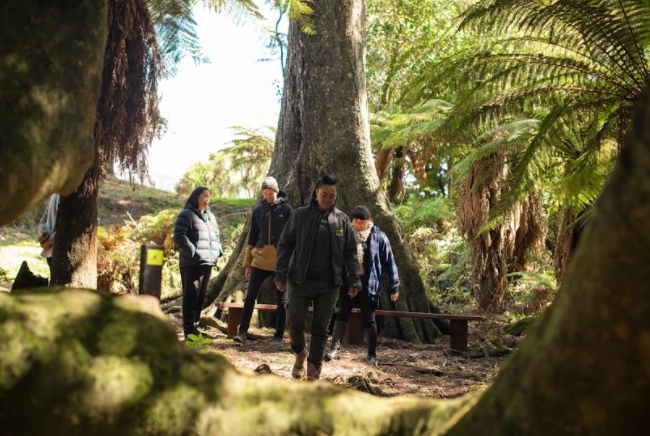Eight destinations for your New Zealand bucket list in 2021
Feed your wanderlust, set your imagination free and check out this fresh list of 8 unique New Zealand destinations to serve as inspiration for your next adventure.

Waitaki Whitestone Geopark
Waitaki Whitestone Geopark is a geological wonder so ancient it’s like visiting another world. Stretching from the alps to the ocean, visitors can explore a 7,200 square kilometre geopark rich in fossils and crisscrossed with easy walks, uphill hikes and cycle routes. The park has 42 geological sites including the famous towering limestone Elephant Rocks, the striking Moeraki Boulders, the pure limestone cliffs and boulders known as the Waipata Earthquakes and the famous Takiroa Māori rock drawings.
The park, which has applied for Unesco Global Geopark status, is rich in wildlife and Shag Point Scientific Reserve offers up a special spot to glimpse rare yellow-eyed penguins, sooty shearwaters, seals and shags.
Te Urewera Treks, Central North Island

At three weeks old Hine McManus was carted off into the bush in her mother’s raincoat and since then has left only to attend work and school. That bush – Te Urewera – is one of New Zealand’s most isolated and pristine rainforests. Home to the Tūhoe people, it was the world’s first natural resource to be granted the same rights as a legal person. McManus now acts as a Tūhoe guide through the 212,000 hectare rainforest, taking guests on treks lasting from three hours to four days where they can ride horses, fish, mountain bike or visit Māori communities where fluent te reo Māori is spoken. Visitors can plant native indigenous trees, earning them status as Kaitiaki Tautoko, or honorary guardian of the forest.
The Chef’s Table at Blue Duck Station, Retarukse

With a passion for local and foraged ingredients, famed British chef Jack Cashmore swapped Michelin-starred restaurants in England and Europe for a vast and rugged New Zealand farm. Affectionately dubbed ‘the top of the world’, it’s located between the Whanganui and Tongariro national parks in the heart of the North Island, and so remote diners are helicoptered in before dinner is served. The Chef’s Table at Blue Duck station is also a farm and conservation project, home to the critically endangered whio, or native blue duck.
The experience begins with a two-hour ATV bush safari before guests settle in under the stars to feast on a 10-course degustation using organic ingredients sourced from the farm and foraged from the surrounding native rainforest.
Owhaoko luxury cabin, Taupō
There’s no roads, no people, no internet and no cell phone coverage at Owhaoko, making it the perfect place for a digital detox in a luxury cabin with views so spectacular one of the bedrooms is made of glass. Nestled between the Kaimanawa and Kaweka forests in the central North Island is the ancestral land of Owhaoko, which covers more than 16,000 private acres of pristine native bush and can only be reached by helicopter.
The luxury cabin’s Māori name is Te Whare Ruruhau (a place of shelter, refuge and protection) has two double bedrooms – one with glass walls and ceiling – and guests can enjoy everything from a bubble bath under the stars with champagne to gourmet meals cooked using traditional Māori methods.
Camp Glenorchy Eco Retreat, Glenorchy
When Seattle philanthropists Paul and Debbi Brainerd first visited the Central Otago town of Glenorchy more than 20 years ago, they fell so deeply in love with the stunning natural landscape they decided to move there. Recently the couple decided to give back to their adopted hometown and bought a dilapidated campsite, rebuilding it as an ultra-green facility constructed mostly from recycled materials, powered with solar energy, and works from local artists incorporated throughout the site. Guests are encouraged to take part in yoga classes, sustainability tours and local food and wine tasting.
MaxingTrax inclusive tourism, Nelson
Jezz Williams was a guide leading a canyoning tour in the Swiss Alps in 2010 when he slipped and fell, breaking his neck and losing the use of his limbs. By 2012 he had started his own business, MakingTrax, which he describes as promoting “inclusive tourism”, helping adventure tourism operators make their activities accessible to all. Using a network of disability-friendly local operators in the Nelson Tasman region, people with disabilities can take part in everything from a canyon swing, skydiving and white water rafting to traditional waka (Māori canoe) along the Abel Tasman coastline and helicopter trips to the famous Franz and Fox glaciers.
Footprint Waipoua tours, Northland
Deep in the North Island’s ancient Waipoua Forest stand some of New Zealand’s oldest and most sacred living legends – the kauri trees that Māori believe to be protectors of the forest.
Wait until twilight when local Māori guides will perform a traditional powhiri (greeting) and sing waiata (songs) before taking tours to meet two of their ancestors: the mighty Te Matua Ngahere (‘The Father of the Forest’) a tree estimated to be between 2,500 and 3000 years old and the impressive Tāne Mahuta (‘Lord of the Forest’), who at 150ft tall is New Zealand’s tallest kauri. Tree hugging is optional but encouraged.
Forest bathing at Orokonui Ecosanctuary, Dunedin
There are no phones or watches allowed on guide Hagino Baker’s forest bathing tour at Orokonui Ecosanctuary. “I am here to slow you down,” she says while leading guests deep into a 307-hectare nature and wildlife reserve north of Dunedin. Two-and-a-half hours of listening, looking, touching and breathing in everything Orokonui’s ancient trees have to offer. Hagino gives the traditional Japanese practise a uniquely Kiwi touch, teaching forest bathers the Māori names for the many native plants and animals found in Orokonui and encouraging tasting of edible leaves and finishing with steaming cups of tea made from the native kanuka bush.
Advertisement
Around The World
Advertisement



